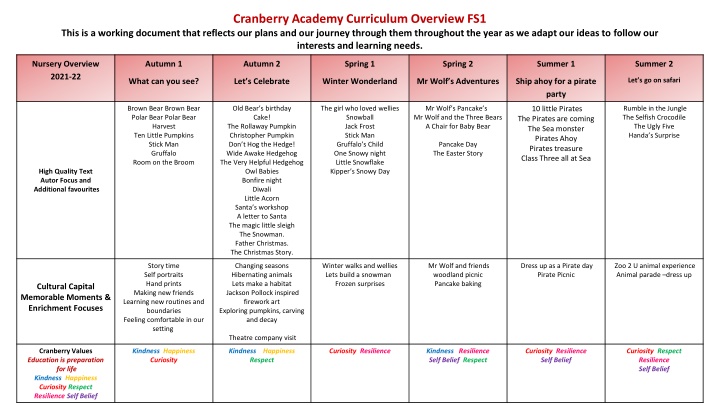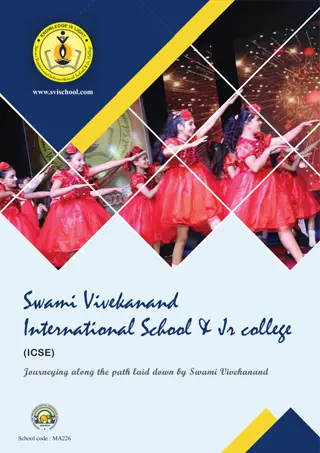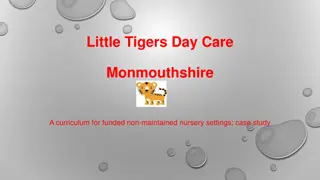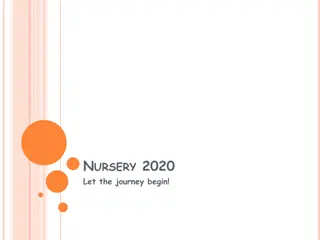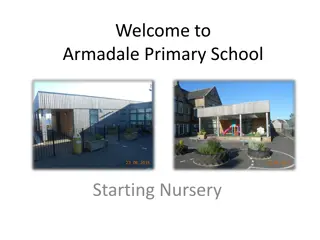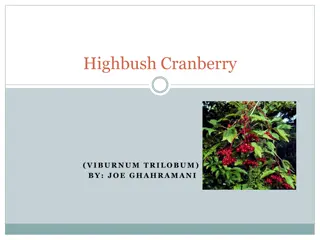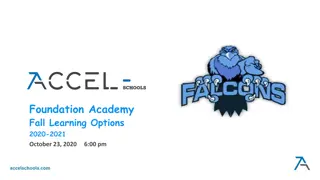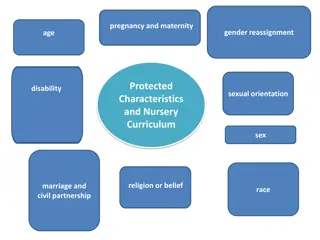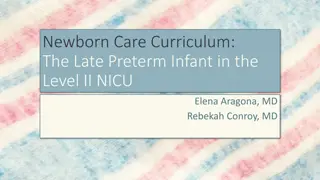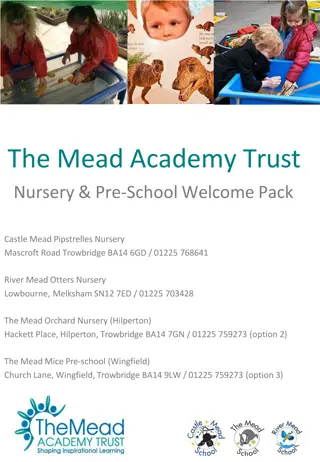Cranberry Academy Nursery Curriculum Overview for FS1
This detailed document outlines the curriculum overview for the Nursery program at Cranberry Academy, highlighting themes, activities, assessment opportunities, parental involvement, and the focus on key developmental areas throughout the academic year. The curriculum emphasizes a diverse range of topics, from safari adventures to winter celebrations, aimed at fostering children's development and exploration in a supportive learning environment. With a focus on holistic growth and building essential skills, the curriculum ensures a well-rounded educational experience for the young learners.
Download Presentation

Please find below an Image/Link to download the presentation.
The content on the website is provided AS IS for your information and personal use only. It may not be sold, licensed, or shared on other websites without obtaining consent from the author.If you encounter any issues during the download, it is possible that the publisher has removed the file from their server.
You are allowed to download the files provided on this website for personal or commercial use, subject to the condition that they are used lawfully. All files are the property of their respective owners.
The content on the website is provided AS IS for your information and personal use only. It may not be sold, licensed, or shared on other websites without obtaining consent from the author.
E N D
Presentation Transcript
Cranberry Academy Curriculum Overview FS1 This is a working document that reflects our plans and our journey through them throughout the year as we adapt our ideas to follow our interests and learning needs. Nursery Overview 2021-22 Autumn 1 Autumn 2 Spring 1 Spring 2 Summer 1 Summer 2 Let s go on safari What can you see? Let s Celebrate Winter Wonderland Mr Wolf s Adventures Ship ahoy for a pirate party Brown Bear Brown Bear Polar Bear Polar Bear Harvest Ten Little Pumpkins Stick Man Gruffalo Room on the Broom Old Bear s birthday Cake! The Rollaway Pumpkin Christopher Pumpkin Don t Hog the Hedge! Wide Awake Hedgehog The Very Helpful Hedgehog Owl Babies Bonfire night Diwali Little Acorn Santa s workshop A letter to Santa The magic little sleigh The Snowman. Father Christmas. The Christmas Story. The girl who loved wellies Snowball Jack Frost Stick Man Gruffalo s Child One Snowy night Little Snowflake Kipper s Snowy Day Mr Wolf s Pancake s Mr Wolf and the Three Bears A Chair for Baby Bear Rumble in the Jungle The Selfish Crocodile The Ugly Five Handa s Surprise 10 little Pirates The Pirates are coming The Sea monster Pirates Ahoy Pirates treasure Class Three all at Sea Pancake Day The Easter Story High Quality Text Autor Focus and Additional favourites Story time Self portraits Hand prints Making new friends Learning new routines and boundaries Feeling comfortable in our setting Changing seasons Hibernating animals Lets make a habitat Jackson Pollock inspired firework art Exploring pumpkins, carving and decay Winter walks and wellies Lets build a snowman Frozen surprises Mr Wolf and friends woodland picnic Pancake baking Dress up as a Pirate day Pirate Picnic Zoo 2 U animal experience Animal parade dress up Cultural Capital Memorable Moments & Enrichment Focuses Theatre company visit Cranberry Values Education is preparation for life Kindness Happiness Curiosity Respect Resilience Self Belief Kindness Happiness Curiosity Kindness Happiness Respect Curiosity Resilience Kindness Resilience Self Belief Respect Curiosity Resilience Self Belief Curiosity Respect Resilience Self Belief
Cranberry Academy Curriculum Overview FS1 Nursery Overview 2021-22 Autumn 1 Autumn 2 Spring 1 Spring 2 Summer 1 Summer 2 Let s go on safari What can you see? Let s Celebrate Winter Wonderland Mr Wolf s Adventures Ship ahoy for a pirate party Entry baseline new starters EYFS team meetings Daily Phase 1 phonics and listening activities Supported play throughout the sessions. EYFS team meetings Autumn data onto DC Pro Pupil progress meetings with SLT Analysis of Autumn data EYFS team meeting EYFS team meetings Pupil progress meetings with SLT Spring summative data onto DC Pro Analysis of Spring Data EYFS team meetings Pupil progress meetings with SLT EYFS team meetings Assessment Opportunities Summer summative data onto DC Pro End of year reports to parents Dojo communications set up and used daily Go Read reading books Dojo communications set up and used daily Go Read reading books Home learning expectations EYFS Nativity production Next step target sheets shared parents phone calls Dojo communications set up and used daily Go Read reading books Dojo communications set up and used daily Go Read reading books Next step target sheets shared parents phone calls Dojo communications set up and used daily Go Read reading books Dojo communications set up and used daily Go Read reading books Home learning expectations EYFS Nativity production Next step target sheets shared parents phone calls Parental Involvement
Cranberry Academy Curriculum Overview FS1 Prime Areas Autumn 1 Autumn 2 Spring 1 Spring 2 Summer 1 Summer 2 The development of children s spoken language underpins all seven areas of learning and development. Children s back-and-forth interactions from an early age form the foundations for language and cognitive development. The number and quality of the conversations they have with adults and peers throughout the day in a language-rich environment is crucial. By commenting on what children are interested in or doing, and echoing back what they say with new vocabulary added, practitioners will build children's language effectively. Reading frequently to children, and engaging them actively in stories, non-fiction, rhymes and poems, and then providing them with extensive opportunities to use and embed new words in a range of contexts, will give children the opportunity to thrive. Through conversation, story-telling and role play, where children share their ideas with support and modelling from their teacher, and sensitive questioning that invites them to elaborate, children become comfortable using a rich range of vocabulary and language structures. Communication and Language C&L is developed throughout the year through high quality individual or group interactions, daily group discussions, circle times, PSHE, stories, singing, speech and language interventions , Pie Corbett T4W actions, EYFS productions & assemblies. Maintains attention, concentrating in a small group/ whole class learning . Able to listen and complete activities for short periods of time. Listening to stories without pictures/props. Respond to 2 part instructions. Listens well to ideas expressed by peers. Uses language to imagine and recreate roles . Uses past, present and future tense. Uses talk to help organise thinking and clarify ideas, feelings, events. Introduce narrative to their play. Settling in activities. Getting to know each other. Circle time games, listening and joining in. My favourite colour, nursery rhyme Singing songs, joining in with actions Listening to short stories and responding to questions about the pictures. Learning vocabulary related to experiences. Sharing my likes and dislikes with my friends Talking about my family Talking about birthdays, sharing my ideas and experiences. Learning vocabulary related to experiences.
Cranberry Academy Curriculum Overview FS1 Prime Areas Autumn 1 Autumn 2 Spring 1 Spring 2 Summer 1 Summer 2 Children s personal, social and emotional development (PSED) is crucial for children to lead healthy and happy lives, and is fundamental to their cognitive development. Underpinning their personal development are the important attachments that shape their social world. Strong, warm and supportive relationships with adults enable children to learn how to understand their own feelings and those of others. Children should be supported to manage emotions, develop a positive sense of self, set themselves simple goals, have confidence in their own abilities, to persist and wait for what they want and direct attention as necessary. Through adult modelling and guidance, they will learn how to look after their bodies, including healthy eating, and manage personal needs independently. Through supported interaction with other children, they learn how to make good friendships, co-operate and resolve conflicts peaceably. These attributes will provide a secure platform from which children can achieve at school and in later life. Children explore activities with more confidence and curiosity Increasingly follow rules Understand why rules are important Sees themselves as valuable individuals Manages their own needs Separate from care giver easily knowing they will return. Finds solutions to conflicts Know and talk about the different factors that support their overall health and wellbeing Talks with others to solve conflicts Builds constructive and respectful relationships Personal, Social & Emotional Development Play with peers showing increasing confidence Remembers rules without an adult needing to remind them Build positive relationships with adults and peers in our setting. Understands gradually how others might be feeling Expresses their feelings and the feelings of others Managing Self, Develops friendships with other children Develop appropriate ways of being assertive Understand and follow most class routines and expectations. Self Regulation Select and use activities and resources Makes healthy choices about food, drink, activity and toothbrushing & Talks about their feelings using words happy, ad, angry, worried Recognise how they feel and be able to ask for help if needed. Building Relationships Grow in independence rejecting help Increasingly able to talk about and manage their emotions Manage some care needs alone, for example toilet, and washing hands. Develop a sense of responsibility Begin to play alongside others. Self-regulatory skills can be defined as the ability of children to manage their own behaviour and aspects of their learning. In the early years, efforts to develop self-regulation often seek to improve levels of self-control and reduce impulsivity. Activities typically include supporting children in articulating their plans and learning strategies and reviewing what they have done. Education Endowment Foundation.
Cranberry Academy Curriculum Overview FS1 Prime Areas Autumn 1 Autumn 2 Spring 1 Spring 2 Summer 1 Summer 2 Physical activity is vitalin children s all-round development, enabling them to pursue happy, healthy and active lives. Gross and fine motor experiences develop incrementally throughout early childhood, starting with sensory explorations and the development of a child s strength, co-ordination and positional awareness through tummy time, crawling and play movement with both objects and adults. By creating games and providing opportunities for play both indoors and outdoors, adults can support children to develop their core strength, stability, balance, spatial awareness, co-ordination and agility. Gross motor skills provide the foundation for developing healthy bodies and social and emotional well-being. Fine motor control and precision helps with hand-eye co-ordination, which is later linked to early literacy. Repeated and varied opportunities to explore and play with small world activities, puzzles, arts and crafts and the practice of using small tools, with feedback and support from adults, allow children to develop proficiency, control and confidence. * Start taking part in some group activities which they make up for themselves, or in teams. Increasingly able to use and remember sequences and patterns of movements which are related to music and rhythm. Match their developing physical skills to tasks and activities in the setting. For example, they decide whether to crawl, walk or run across a plank, depending on its length and width. Choose the right resources to carry out their own plan. For example, choosing a spade to enlarge a small hole they dug with a trowel. Collaborate with others to manage large items, such as moving a long plank safely, carrying large hollow blocks Revise and refine the fundamental movement skills they have already acquired: - rolling - crawling - walking - jumping - running - hopping - skipping - climbing Develop their small motor skills so that they can use a range of tools competently, safely and confidently. Suggested tools: pencils for drawing and writing, paintbrushes, scissors, knives, forks and spoons. Use their core muscle strength to achieve a good posture when sitting at a table or sitting on the floor. Combine different movements with ease and fluency. Confidently and safely use a range of large and small apparatus indoors and outside, alone and in a group *Use large and small motor skills to do things independently, for example manage buttons and zips, and pour drinks. Show an increasing desire to be independent, such as wanting to feed themselves and dress or undress. Start eating independently and learning how to use a knife and fork. Develop manipulation and control. Explore different materials and tools. * Turn the pages in a book, sometimes more than one. * Hold a pencil (fisted/digital pronate grip) to make marks. Begin to do up my own large buttons. Show a preference for a dominant hand * Develop strong core muscles by experimenting with different movements. Outdoor activities such as riding, scooting, running, jumping, climbing and team games. Continue to develop their movement, balancing, riding (scooters, trikes and bikes) and ball skills. Physical Development Fine Motor Go up steps and stairs, or climb up apparatus, using alternate feet. Continuously check the process of children s handwriting (pencil grip and letter formation, including directionality). Provide extra help and guidance when needed. Progress towards a more fluent style of moving, with developing control and grace. * Daily rhymes and dance movements to support, shoulder and elbow pivots. Skip, hop, stand on one leg and hold a pose for a game like musical statues. Develop the overall body strength, co-ordination, balance and agility needed to engage successfully with future physical education sessions and other physical disciplines including dance, gymnastics, sport and swimming.. . Use one-handed tools and equipment, for example, making snips in paper with scissors. Use a comfortable grip with good control when holding pens and pencils.. Be increasingly independent as they get dressed and undressed, for example, putting coats on and doing up zips. Use large-muscle movements to wave flags and streamers, paint and make marks. & Gross Motor * Use the pincer grasp between fingers and thumb to pick up small beads/objects. * Dough gym and funky fingers daily activities.
Cranberry Academy Curriculum Overview FS1 Specific Areas Autumn 1 Autumn 2 Spring 1 Spring 2 Summer 1 Summer 2 It is crucial for children to develop a life-long love of reading. Reading consists of two dimensions: language comprehension and word reading. Language comprehension (necessary for both reading and writing) starts from birth. It only develops when adults talk with children about the world around them and the books (stories and non-fiction) they read with them, and enjoy rhymes, poems and songs together. Skilled word reading, taught later, involves both the speedy working out of the pronunciation of unfamiliar printed words (decoding) and the speedy recognition of familiar printed words. Writing involves transcription (spelling and handwriting) and composition (articulating ideas and structuring them in speech, before writing) Engage in extended conversations about stories, learning new vocabulary. * Develop their phonological awareness, so that they can: * Enjoy songs and rhymes, tuning in and paying attention. Have favourite books and seek them out, to share with an adult, with another child, or to look at alone. *Write some familiar letters accurately. Begins to write some or all of their name. Literacy Begins to write some letters accurately. Reads individual letters by saying the sounds for them. Word Reading, - spot and suggest rhymes Join in with songs and rhymes, copying sounds, rhythms, tunes and tempo. Repeat words and phrases from familiar stories Comprehension Use some of their print and letter knowledge in their early writing. For example: writing a pretend shopping list that starts at the top of the page; writing m for mummy. - count or clap syllables in a word & Writing Say some of the words in songs and rhymes. Notice some print, such as the first letter of their name, a bus or door number, or a familiar logo. (Recognises important prints to me) - - recognise words with the same initial sound, such as money and mother We use the SSP Little Wandle Letters & Sounds Revisied to teach Literacy which will be reinforced through challenge & enhancements in the Continuous Provision Sing songs and say rhymes independently, for example, singing whilst playing. Enjoy sharing books with an adult. Engage in extended conversations about stories, learning new vocabulary. Add some marks to their drawings, which they give meaning to. For example: That says mummy. Pay attention and respond to the pictures or the words * Make marks on their picture to stand for their name (recognise important prints to me) *Sing songs and say rhymes independently, for example, singing whilst playing. Enjoy drawing freely.
Cranberry Academy Curriculum Overview FS1 Specific Areas Autumn 1 Autumn 2 Spring 1 Spring 2 Summer 1 Summer 2 Developing a strong grounding in number is essential so that all children develop the necessary building blocks to excel mathematically. Children should be able to count confidently, develop a deep understanding of the numbers to 10, the relationships between them and the patterns within those numbers. By providing frequent and varied opportunities to build and apply this understanding - such as using manipulatives, including small pebbles and tens frames for organising counting - children will develop a secure base of knowledge and vocabulary from which mastery of mathematics is built. In addition, it is important that the curriculum includes rich opportunities for children to develop their spatial reasoning skills across all areas of mathematics including shape, space and measures. It is important that children develop positive attitudes and interests in mathematics, look for patterns and relationships, spot connections, have a go , talk to adults and peers about what they notice and not be afraid to make mistakes. Recite numbers past 5. * Counts in everyday contexts, sometimes skipping numbers - 1-2-3-5. *Talks about and explore 2D shapes using informal and mathematical language: sides , corners ; straight , flat , round . *Notice and correct an error in a repeating pattern. Develops fast recognition of up to 3 objects, without having to count them individually ( subitising ). . Describes a familiar route. Discuss routes and locations, using words like in front of and behind . Say one number for each item in order: 1,2,3,4,5. Begins to describe a sequence of events, real or fictional, using words such as first , then... Mathematics Climb and squeeze themselves into different types of spaces. Know that the last number reached when counting a small set of objects tells you how many there are in total ( cardinal principle ). Number Link numerals and amounts: for example, showing the right number of objects to match the numeral, up to 5. *Talks about and explore 2D and 3D shapes (for example, circles, rectangles, triangles and cuboids) using informal and mathematical language: sides , corners ; straight , flat , round . Understand position through words alone for example, The bag is under the table, with no pointing & Numerical Patterns Build with a range of resources. Makes comparisons between objects relating to size, length, weight and capacity. Show finger numbers up to 5. Complete inset puzzles. These skills will be revisited and supported through challenge & enhancements within the Continuous Provision Experiment with their own symbols and marks as well as numerals. Compare sizes, weights etc. using gesture and language - bigger/little/smaller , high/low , tall , heavy . Solve real world mathematical problems with numbers up to 5. Selects shapes appropriately: flat surfaces for building, a triangular prism for a roof, etc Compare quantities using language: more than , fewer than . Notice patterns and arrange things in patterns. Talk about and identifies the patterns around them. Uses informal language like pointy , spotty , blobs , etc. Combine shapes to make new ones an arch, a bigger triangle, etc. Extend and create ABAB patterns stick, leaf, stick, leaf.
Cranberry Academy Curriculum Overview FS1 Specific Areas Autumn 1 Autumn 2 Spring 1 Spring 2 Summer 1 Summer 2 Understanding the world involves guiding children to make sense of their physical world and their community. The frequency and range of children s personal experiences increases their knowledge and sense of the world around them from visiting parks, libraries and museums to meeting important members of society such as police officers, nurses and firefighters. In addition, listening to a broad selection of stories, non-fiction, rhymes and poems will foster their understanding of our culturally, socially, technologically and ecologically diverse world. As well as building important knowledge, this extends their familiarity with words that support understanding across domains. Enriching and widening children s vocabulary will support later reading comprehension. Understanding the World * Repeats actions that have an effect. *Talk about what they see, using a wide vocabulary. Begin to understand the need to respect and care for the natural environment and all living things. *Continue developing positive attitudes about the differences between people. Explore and respond to different natural phenomena in their setting and on trips. Show interest in different occupations. Explore how things work Explores materials with different properties. Past & Present, Begin to make sense of their own life-story and family s history. . Make connections between the features of their family and other families. Plant seeds and care for growing plants. Know that there are different countries in the world and talk about the differences they have experienced or seen in photos. People, Culture & Communities Explore natural materials, indoors and outside. * Explore and talk about different forces they can feel. Notice differences between people. Understand the key features of the life cycle of a plant and an animal. & The Natural World Use all their senses in hands- on exploration of natural materials. Talk about the differences between materials and changes they notice. Explore collections of materials with similar and/or different properties.
Cranberry Academy Curriculum Overview FS1 Specific Areas Autumn 1 Autumn 2 Spring 1 Spring 2 Summer 1 Summer 2 The development of children s artistic and cultural awareness supports their imagination and creativity. It is important that children have regular opportunities to engage with the arts, enabling them to explore and play with a wide range of media and materials. The quality and variety of what children see, hear and participate in is crucial for developing their understanding, self-expression, vocabulary and ability to communicate through the arts. The frequency, repetition and depth of their experiences are fundamental to their progress in interpreting and appreciating what they hear, respond to and observe. Explore paint, using fingers and other parts of their bodies as well as brushes and other tools. Use their imagination as they consider what they can do with different * Begin to develop complex stories using small world equipment. *Respond to what they have heard, expressing their thoughts and feelings. Draw with increasing complexity and detail, such as representing a face with a circle and including details Show different emotions in their drawings and paintings, like happiness, sadness, fear, etc. Listen with increased attention to sounds.t materials. Make imaginative and complex small worlds with blocks and construction kits, such as a city with different buildings and a park. Remember and sing entire songs. Express ideas and feelings through making marks, and sometimes give a meaning to the marks they make. Develop their own ideas and then decide which materials to use to express them. Create closed shapes with continuous lines, and begin to use these shapes to represent objects. Expressive Arts & Design Creating with Materials Sing the pitch of a tone sung by another person ( pitch match ). Make simple models which express their ideas. & Enjoy and take part in action songs, such as Twinkle, Twinkle Little Star . Join different materials and explore different textures. Move and dance to music. Being Imaginative & Explore different materials freely, to develop their ideas about how to use them and what to make. . Use drawing to represent ideas like movement or loud noises. Make rhythmical and repetitive sounds. Sing the melodic shape (moving melody, such as up and down, down and up) of familiar songs. Expressive Start to develop pretend play, pretending that one object represents another. Explore a range of sound makers and instruments and play them in different ways. Join in with songs and rhymes, making some sounds Create their own songs or improvise a song around one they know. Take part in simple pretend play, using an object to represent something else even though they are not similar. *Explore different materials, using all their senses to investigate them. Play instruments with increasing control to express their feelings and ideas Manipulate and play with different materials. . Explore colour and colour- mixing
